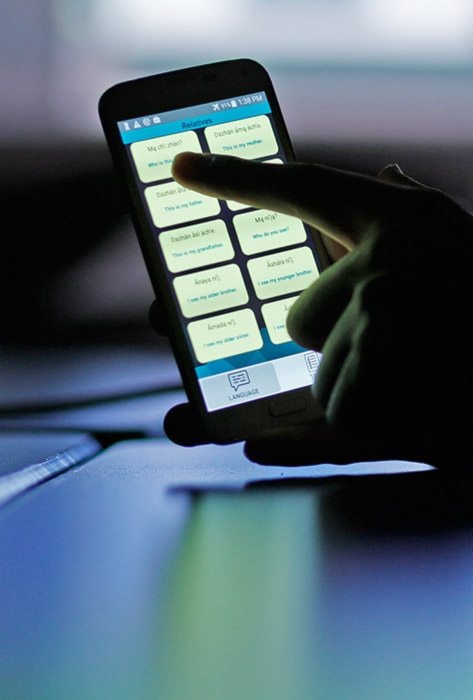Growing up with her grandparents, Nicole Smith was familiar with a handful of Southern Tutchone phrases.
Irene and Elijah Smith mostly spoke to their granddaughter in English, but common phases like “close the door” or “make a cup of tea” would come in Southern Tutchone.
“So I knew those little commands but not much more than that,” Smith said.
What Smith got as a child was a taste of a language that’s at risk of disappearing.
In the 2011 census only 140 Yukoners listed Southern Tutchone as one of the first languages they learned at home and something they still understood.
The federal numbers aren’t broken down into the various individual dialects that were once spoken across much of the southwestern part of the territory.
As she got older, Smith wanted to know more about the language. She got her teaching certificate, found a mentor to help her improve her speaking skills and now teaches Southern Tutchone to children at Whitehorse Elementary School.
Three generations of Smith’s family are part of a new effort by the Ta’an Kwach’an Council to use technology to help preserve its language.
The First Nation is creating a phone app that will allow users to learn words and phrases in the Ta’an dialect of Southern Tutchone.
With the press of a button, users will be able to hear Irene Smith articulate everyday words and phrases to repeat.
In 2003, years before she died, Irene Smith recorded herself speaking Southern Tutchone for the Yukon Native Language Centre. The recordings first became part of a conventional language lesson and are now the centrepiece of the app.
Nicole Smith and her mother, Linda Harvey, who both speak Southern Tutchone, are helping with more words and phrases for the app as they come up.
Ta’an Kwach’an Council deputy chief Michelle Telep said the free app is meant to make learning the language accessible to anyone who has a smartphone.
As it stands, the First Nation only has “a handful” of fluent speakers left, she said.
“I’ve had a lot of elders approach me and say our language is very important to keeping our identity and who we are as Ta’an people. So we need to really work at preserving that language.”
Being able to hear someone speaking Southern Tutchone is important when it comes to learning the language, said Loretta Jensen, a linguist with the Yukon Native Language Centre. In Southern Tutchone, knowing what tone to use is part of expressing yourself.
“These languages, the tone itself, whether it goes up and down can change the meaning of the word itself,” Jensen said.
The language is also polysynthetic, meaning some single words in Southern Tutchone could translate into a full English sentence.
The First Nation has been working on the project for about the last year. It hired Winnipeg-based Ogoki Learning to develop the app and local staff have been trained to maintain it and upload more audio files.
Right now it has about 600 common words and phrases, said Chantelle Blackjack, the First Nation’s heritage program coordinator. The plan is to eventually add more content and expand what the app is capable of doing.
“(We want to) take it one level up from what is existing in the territory right now,” she said. “We are going to incorporate some quizzes, try and encompass the structure of the language. How does it work? How do you put together sentences? How do we become conversational?”
The language program where Nicole Smith works is one of nearly two dozen Indigenous language programs across the territory.
At Whitehorse Elementary School every class gets lessons in Southern Tutchone twice a week.
Smith said she’s sometimes amazed by how fast children will pick up a new language.
“We’re teaching our youth to walk two paths, not just one or the other. Along with teaching them culture, we can teach them culture on iPads.”
So far, the First Nation’s app does not have an official name. Its working title is the Southern Tutchone Ta’an Dialect language app. The First Nation says it will provide updates on its website if the name changes, so anyone interested can search for the app online.
It’s slated to go live on both iTunes and Google Play sometime this week.
If Ta’an’s app is successful, Telep hopes other First Nations will create similar versions for other languages.
It’s something her grandmother would approve of, Nicole Smith said.
“She would definitely have been supportive and same with my grandfather. They were both very supportive of children.”
Contact Ashley Joannou at ashleyj@yukon-news.com
